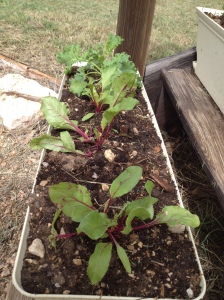With 1 in 8 people hungry in our world, it may seem daunting to think that one individual could make a difference. Fortunately, by taking responsibility for our own food choices we can systematically make a difference in the global food system. Choosing locally produced food items keeps local economies healthy, provides healthy and affordable food and reduces transportation costs which translates to a lower carbon footprint. Better yet, growing one’s own food can produce more food with fewer resources than the large scale industrial agriculture that dominates our grocery shelves, provide nutrition, food security and maintain biodiversity.
Here, at Wolf Ridge Camp at Fossil Rim, we have our own garden, as shown in the last post. Our keyhole garden was modeled after a design used in areas suffering from degraded soil and lack of land, money and resources. The concept of the keyhole garden is that food waste contained in a compost center will provide nutrition to the surrounding plants that, in turn, will feed the gardeners. The garden is above-ground, utilizing found or waste materials to build the retaining wall and filled with layers of cardboard, paper, hay or any other compostable material that will also provide aeration. Topped with composted soil, this garden will be a continuous loop of nutrition and provide food security to the growers.
Our keyhole garden grows kale, lettuce, arugula, sugar snap peas, beets, carrots, broccoli, cauliflower and collard greens. To reduce our need for inputs we also planted mint, which repels aphids and flea beetles along with parsley to keep carrot flies away. Every day I empty my coffee grounds and any food waste from a meal into the compost center along with shredded paper and it provides food for our plants.
The plants are flourishing and have already provided a harvest of beets, arugula, lettuce, spinach and kale.
This garden is easy to replicate, on any budget, and is a great way to take a stand against hunger. Fuel has become more expensive over the years and that cost is part of our shopping bill. In the United States, the average distance a food product traveled from production to plate is 1,500 miles. Combine that with the fact that only 2% of food purchased in the U.S. comes from local and sustainable sources and you’re left with a very high grocery bill. This is one way food, especially healthy food, is out of reach for many people. By growing your own food, participating in a community garden or CSA you can help keep healthy, affordable food in your community and reduce dependency on fossil fuels.
By: Savanna H.






Gardening has always been a passion of mine as a nature women. Ever since childhood I have been interested in the outdoors and growing my own food. Thank you for the great information given in this article. I learned a lot 🙂